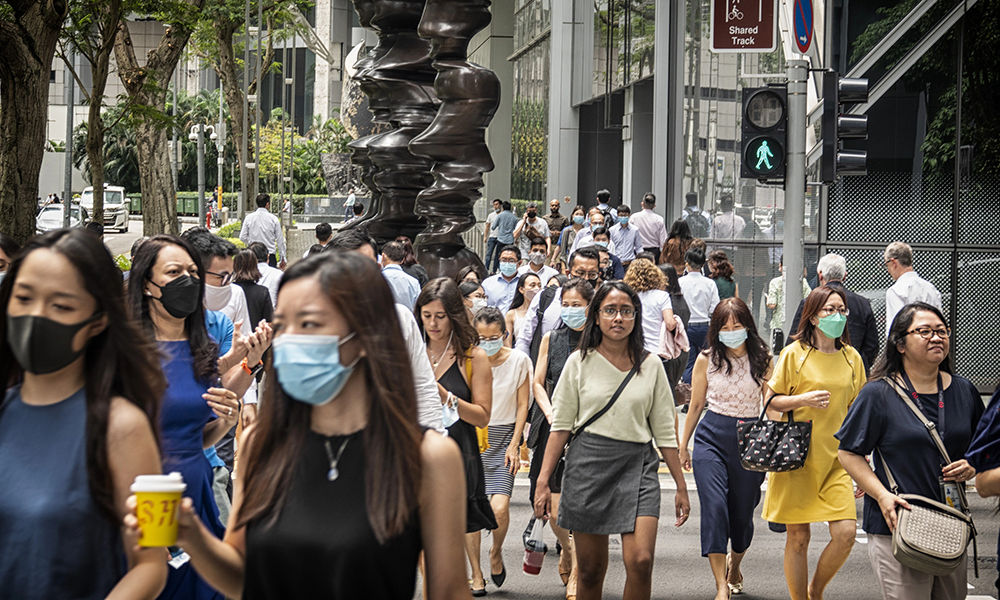
XBB可能是到目前為止免疫逃脫力最強(qiáng)的新冠變異株。世界衛(wèi)生組織(World Health Organization)報(bào)告稱,,在26個(gè)國家已經(jīng)發(fā)現(xiàn)了這種變異株,。
世衛(wèi)組織并未說明發(fā)現(xiàn)XBB變異株的國家。本月,,在新加坡和孟加拉國,,XBB變異株的流行程度上升,盡管新加坡國民已經(jīng)普遍接種疫苗和加強(qiáng)針,。但負(fù)責(zé)跟蹤新冠和流感病毒變化的國際組織全球共享流感數(shù)據(jù)倡議組織(GISAID)的數(shù)據(jù)顯示,,加拿大、英國和印度等國的病例數(shù)也在增多,。
全球共享流感數(shù)據(jù)倡議組織的數(shù)據(jù)顯示,,過去30天,XBB或其子變異株主要集中在新加坡,,其次是印度,、孟加拉國、美國,、澳大利亞和丹麥,。
XBB是兩種不同奧密克戎變異株的結(jié)合體。它正在與奧密克戎BQ.1.1變異株都有可能成為到目前為止免疫逃脫力最強(qiáng)的變異株,。BQ.1.1比今年夏天的全球主要變異株奧密克戎BA.5免疫逃脫力更強(qiáng),。但世衛(wèi)組織的報(bào)告引用“實(shí)驗(yàn)室數(shù)據(jù)”稱,XBB事實(shí)上是抗體逃脫力最強(qiáng)的變異株,。
報(bào)告稱,,雖然XBB傳播的效果似乎遠(yuǎn)超過其他奧密克戎變異株,但關(guān)于它是否會導(dǎo)致更多重癥,,目前尚不可知,。
進(jìn)化的威脅
到目前為止,美國尚未發(fā)現(xiàn)XBB變異株,。但據(jù)全球共享流感數(shù)據(jù)倡議組織的數(shù)據(jù)顯示,,美國已經(jīng)發(fā)現(xiàn)了XBB.1、XBB.2和XBB.3子變異株,。
位于阿肯色州瓊斯博羅的紐約理工學(xué)院(New York Institute of Technology)的研究助理院長和副教授垃吉·拉吉納拉亞南周一引用全球共享流感數(shù)據(jù)倡議組織的數(shù)據(jù),,對《財(cái)富》雜志表示,美國在9月15日最早發(fā)現(xiàn)XBB.1病例,,占過去15天基因測序確診病例的0.26%,。已發(fā)現(xiàn)的XBB變異株大多數(shù)位于紐約州,。
世衛(wèi)組織上周表示,全球已發(fā)現(xiàn)的XBB.1病例是XBB病例的近三倍,。
目前尚不確定XBB的子變異株XBB.1相對于其母變異株有哪些優(yōu)勢,。與XBB相比,,XBB.1只有刺突蛋白有“一點(diǎn)小變化”,。病毒通過刺突蛋白吸附并感染細(xì)胞。拉吉納拉亞南表示,,這種變化的影響目前依舊是未知數(shù),。
與競爭對手BQ.1.1一樣,XBB能夠逃脫抗體免疫,,導(dǎo)致對高風(fēng)險(xiǎn)新冠患者常用的單克抗體藥物無效,。在中國,北京大學(xué)(Peking University)生物醫(yī)學(xué)前沿創(chuàng)新中心(s Biomedical Pioneering Innovation Center in China)的研究發(fā)現(xiàn),,這兩種變異株能夠逃脫對所有變異株均有效的最新單克抗體藥物bebtelovimab,,以及對部分變異株有效的Evusheld。研究的作者表示,,這兩種變異株都會引發(fā)更多重癥,。
作者還表示,XBB具有“極端的”免疫逃脫力,,接近于SARS病毒,。在2000年代初,SARS冠狀病毒導(dǎo)致數(shù)千人感染,,造成近800人死亡,。
包括美國傳染病學(xué)專家安東尼·福奇博士在內(nèi)的科學(xué)家們都預(yù)計(jì),美國今年秋冬會發(fā)生一波疫情,,從本月開始病例大幅增加,,到明年1月達(dá)到最高峰。目前尚不確定,,哪一種變異株會成為這一輪疫情的主要原因,。專家們表示,XBB和BQ.1.1是主要競爭者,。(財(cái)富中文網(wǎng))
譯者:劉進(jìn)龍
審校:汪皓
XBB可能是到目前為止免疫逃脫力最強(qiáng)的新冠變異株,。世界衛(wèi)生組織(World Health Organization)報(bào)告稱,在26個(gè)國家已經(jīng)發(fā)現(xiàn)了這種變異株,。
世衛(wèi)組織并未說明發(fā)現(xiàn)XBB變異株的國家,。本月,在新加坡和孟加拉國,,XBB變異株的流行程度上升,,盡管新加坡國民已經(jīng)普遍接種疫苗和加強(qiáng)針,。但負(fù)責(zé)跟蹤新冠和流感病毒變化的國際組織全球共享流感數(shù)據(jù)倡議組織(GISAID)的數(shù)據(jù)顯示,加拿大,、英國和印度等國的病例數(shù)也在增多,。
全球共享流感數(shù)據(jù)倡議組織的數(shù)據(jù)顯示,過去30天,,XBB或其子變異株主要集中在新加坡,,其次是印度、孟加拉國,、美國,、澳大利亞和丹麥。
XBB是兩種不同奧密克戎變異株的結(jié)合體,。它正在與奧密克戎BQ.1.1變異株都有可能成為到目前為止免疫逃脫力最強(qiáng)的變異株,。BQ.1.1比今年夏天的全球主要變異株奧密克戎BA.5免疫逃脫力更強(qiáng)。但世衛(wèi)組織的報(bào)告引用“實(shí)驗(yàn)室數(shù)據(jù)”稱,,XBB事實(shí)上是抗體逃脫力最強(qiáng)的變異株,。
報(bào)告稱,雖然XBB傳播的效果似乎遠(yuǎn)超過其他奧密克戎變異株,,但關(guān)于它是否會導(dǎo)致更多重癥,,目前尚不可知。
進(jìn)化的威脅
到目前為止,,美國尚未發(fā)現(xiàn)XBB變異株,。但據(jù)全球共享流感數(shù)據(jù)倡議組織的數(shù)據(jù)顯示,美國已經(jīng)發(fā)現(xiàn)了XBB.1,、XBB.2和XBB.3子變異株,。
位于阿肯色州瓊斯博羅的紐約理工學(xué)院(New York Institute of Technology)的研究助理院長和副教授垃吉·拉吉納拉亞南周一引用全球共享流感數(shù)據(jù)倡議組織的數(shù)據(jù),對《財(cái)富》雜志表示,,美國在9月15日最早發(fā)現(xiàn)XBB.1病例,,占過去15天基因測序確診病例的0.26%。已發(fā)現(xiàn)的XBB變異株大多數(shù)位于紐約州,。
世衛(wèi)組織上周表示,,全球已發(fā)現(xiàn)的XBB.1病例是XBB病例的近三倍。
目前尚不確定XBB的子變異株XBB.1相對于其母變異株有哪些優(yōu)勢,。與XBB相比,,XBB.1只有刺突蛋白有“一點(diǎn)小變化”。病毒通過刺突蛋白吸附并感染細(xì)胞,。拉吉納拉亞南表示,,這種變化的影響目前依舊是未知數(shù)。
與競爭對手BQ.1.1一樣,XBB能夠逃脫抗體免疫,,導(dǎo)致對高風(fēng)險(xiǎn)新冠患者常用的單克抗體藥物無效,。在中國,北京大學(xué)(Peking University)生物醫(yī)學(xué)前沿創(chuàng)新中心(s Biomedical Pioneering Innovation Center in China)的研究發(fā)現(xiàn),,這兩種變異株能夠逃脫對所有變異株均有效的最新單克抗體藥物bebtelovimab,,以及對部分變異株有效的Evusheld。研究的作者表示,,這兩種變異株都會引發(fā)更多重癥,。
作者還表示,XBB具有“極端的”免疫逃脫力,,接近于SARS病毒,。在2000年代初,SARS冠狀病毒導(dǎo)致數(shù)千人感染,,造成近800人死亡。
包括美國傳染病學(xué)專家安東尼·福奇博士在內(nèi)的科學(xué)家們都預(yù)計(jì),,美國今年秋冬會發(fā)生一波疫情,,從本月開始病例大幅增加,到明年1月達(dá)到最高峰,。目前尚不確定,,哪一種變異株會成為這一輪疫情的主要原因。專家們表示,,XBB和BQ.1.1是主要競爭者,。(財(cái)富中文網(wǎng))
譯者:劉進(jìn)龍
審校:汪皓
XBB—quite possibly the most immune-evasive COVID variant to date—has been identified in 26 countries, the World Health Organization reported Wednesday.
The organization did not name the countries in which it had found XBB. Levels of the variant have been rising in Singapore this month, despite a broadly vaccinated and boosted population, as well as in Bangladesh. But cases are also rising in other countries, including Canada, England, and India, according to data from GISAID, an international research organization that tracks changes in COVID and the flu virus.
GISAID data shows the largest concentration of XBB or spinoff variants over the past 30 days in Singapore, followed by India, Bangladesh, the U.S., Australia, and Denmark.
XBB is a combination of two different strains of Omicron. It’s in competition with fellow Omicron spawn BQ.1.1 for the title of most immune-evasive variant so far, surpassing that of shared ancestor BA.5, which was dominant across the globe this summer. But the WHO report suggested that XBB is indeed the most antibody-evasive variant yet, citing “l(fā)aboratory-based evidence.”
While XBB also seems to spread more effectively than other Omicron variants, it’s yet known if it causes more severe disease than other strains, the report added.
An evolving threat
XBB has not been identified in the U.S. so far. But spinoffs of it—XBB.1, XBB.2, and XBB.3—have, according to GISAID data.
XBB.1 was first detected in the U.S. on Sept. 15, and represented 0.26% of cases genetically sequenced over the past 15 days, Raj Rajnarayanan, an assistant dean of research and associate professor at the New York Institute of Technology campus in Jonesboro, Ark., told?Fortune?on Monday, citing GISAID data. Most XBB strains had been found in New York State.
Worldwide, nearly three times as many cases of XBB.1 had been identified as cases of XBB, the WHO said this week.
It’s currently unclear what advantages, if any, XBB descendants like XBB.1 might have over their parent variant. Compared with XBB, XBB.1 features just “one small change” to the spike protein, which the virus uses to attach to and infect cells. The impact of the alteration is unknown, Rajnarayanan said.
XBB, in addition to competitor BQ.1.1, escape antibody immunity, rendering useless monoclonal antibody treatments used in high-risk individuals with COVID. According to a study last month out of Peking University’s Biomedical Pioneering Innovation Center in China, both escape immunity from bebtelovimab, the last monoclonal antibody drug that is effective on all variants, as well as Evusheld, which works on some. And both could lead to more severe symptoms, the authors wrote.
The ability of XBB to evade immunity is “extreme,” approaching the level of immune evasion shown by SARS, a coronavirus that infected thousands and caused nearly 800 deaths in the early 2000s, the authors added.
Scientists, including top U.S. infectious disease expert Dr. Anthony Fauci, expect a fall and winter wave of cases in the U.S. that begins to surge this month and peaks in January. It’s still unclear which COVID variant may fuel that wave, if any one variant does. But XBB and BQ.1 are top contenders, experts say.






